Blog/CRM/Guide to CRM Migration to Salesforce on Alibaba Cloud in China
In China’s rapidly evolving digital landscape, businesses face increasing challenges in managing customer relationships effectively. Fragmented systems and disconnected data sources often hinder seamless engagement, making it difficult to gain a unified customer view and optimize operations.
To succeed, companies need a centralized CRM that not only streamlines all data flows but also ensures compliance with China’s stringent data regulations.
In response to these challenges, Salesforce on Alibaba Cloud provides a localized Customer 360 solution tailored for the Chinese market. This comprehensive guide explores the evolution of CRM in China, the advantages of Salesforce on Alibaba Cloud, and a step-by-step approach to a successful CRM migration.
Table of Contents
- The Evolution of CRM in China
- Why Choose Salesforce on Alibaba Cloud as the CRM Solution for China?
- Step-by-Step Guide to Salesforce on Alibaba Cloud Migration
- Work with ITC as Your Salesforce Implementation Partner in China
The Evolution of CRM in China
Customer relationship management (CRM) in China has evolved uniquely, driven by the country’s digital ecosystem and consumer behaviors.
Unlike in Western markets, where CRM systems rely heavily on email marketing for product promotions, customer service, and engagement, email adoption in China remains low - many consumers rarely check their inboxes, while others do not have an email address at all.
As a result, CRM in China is deeply integrated with super apps like WeChat, which serve as primary platforms for communication, transactions, and brand engagement.
One of the most critical aspects of CRM in China is private traffic, which enables brands to engage directly with customers within closed digital environments.
WeChat, the prominent private traffic domain, has long been viewed as a “CRM system” in itself, offering brands unparalleled ways to collect, control, and own 100% of customer data from various touchpoints. Key data collection channels include (in no particular order):
- WeChat Official Accounts: Enhanced by Marketing Automation/Social CRM tools, brands can capture user data through parametric QR codes, auto-reply answers, forms, user online interactions, and automatic tagging/segmentation…
- WeCom: Enables data collection via parametric QR codes and manual tagging by sales associates (complementing the above automatic tagging)…
- WeChat Mini Programs: Facilitates data collection through quick registration form (capturing user information such as mobile numbers and location), parametric QR codes, user online interactions, forms, and purchase history…
Beyond data collection, these interconnected touchpoints can support the full customer lifecycle - from acquisition to engagement and conversion - by delivering customized content, targeted offers, and tailored interactions at every stage of the journey.
WeChat and WeCom also play a crucial role in bridging private traffic and in-store experiences, ensuring consistent messaging, driving O2O traffic, and delivering seamless, personalized omnichannel customer journeys.
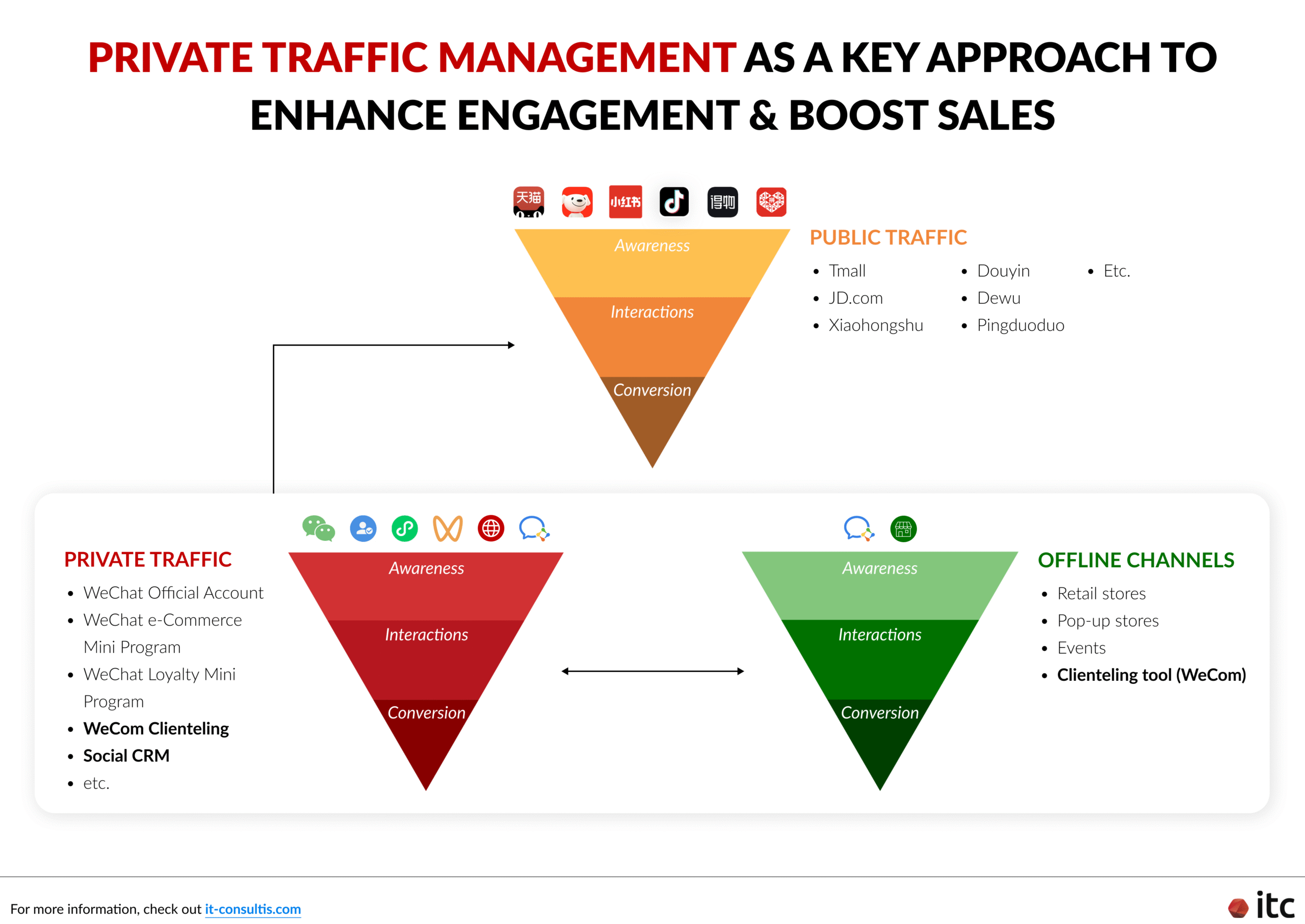
To enhance their CRM capabilities, brands can also partner with an independent software vendor (ISV) to extract data (where possible) from public traffic domains, including marketplaces and other social media platforms, and drive cross-platform loyalty.
However, while private traffic management remains a solid foundation for CRM in China, WeChat and WeCom’s native capabilities fall short of providing robust CRM functionalities, and they represent only a few of the various critical channels in the market.
To stay ahead and succeed, brands must establish a centralized CRM system in China that:
- Consolidates all data flows to craft holistic profiles and streamline task management
- Bridges global and local CRM
Here’s where Salesforce China comes in.
Why Choose Salesforce on Alibaba Cloud as the CRM Solution for China?
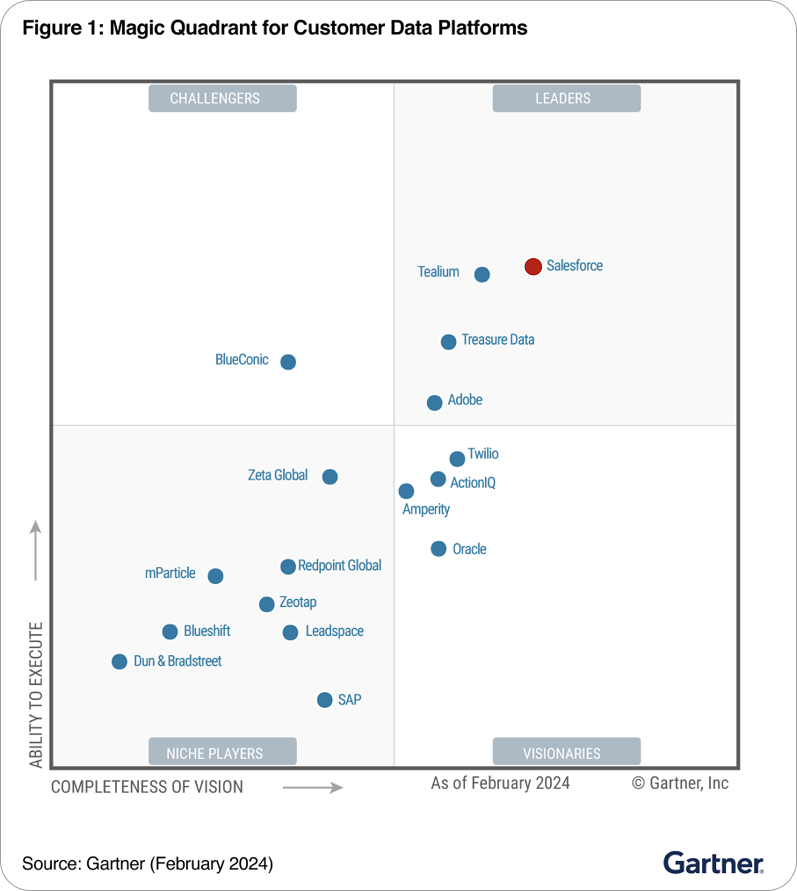
Recognized as the world’s leading CRM provider, Salesforce, in partnership with Alibaba Cloud, has developed a localized Customer 360 solution.
This solution streamlines cross-departmental coordination throughout the customer journey, offering a complete, centralized view of customer data that enables personalized experiences, boosts conversions, and strengthens long-term loyalty.
By combining their expertise, Salesforce and Alibaba Cloud enhance their service offerings, equipping businesses in China, particularly multinational corporations, with the following advantages:
- Empowering local customer engagement platforms (e.g., WeCom, WeChat…) and local internet ecosystems (e.g., map services, payment services, social media services, eCommerce services)
- Facilitating seamless integration with local business systems (e.g., POS, OMS, PIM) and global CRM (e.g., global Salesforce instance)
- Integrating with local data analytics, consumer insights tools, and Marketing Automation solutions
- Ensuring compliance with China’s data residency regulations by hosting data on Alibaba Cloud
- Enhancing performance and accessibility through Alibaba Cloud's secure and compliant cloud infrastructure
While Salesforce on Alibaba Cloud comes with an additional collection of Marketing Automation/Social CRM tools that empower the CRM’s integration with local Chinese touchpoints, onboarding these systems is not a must.
Thanks to Salesforce on Alibaba Cloud’s out-of-the-box open interfaces, brands can choose to keep and integrate their existing Marketing Automation systems with the CRM.
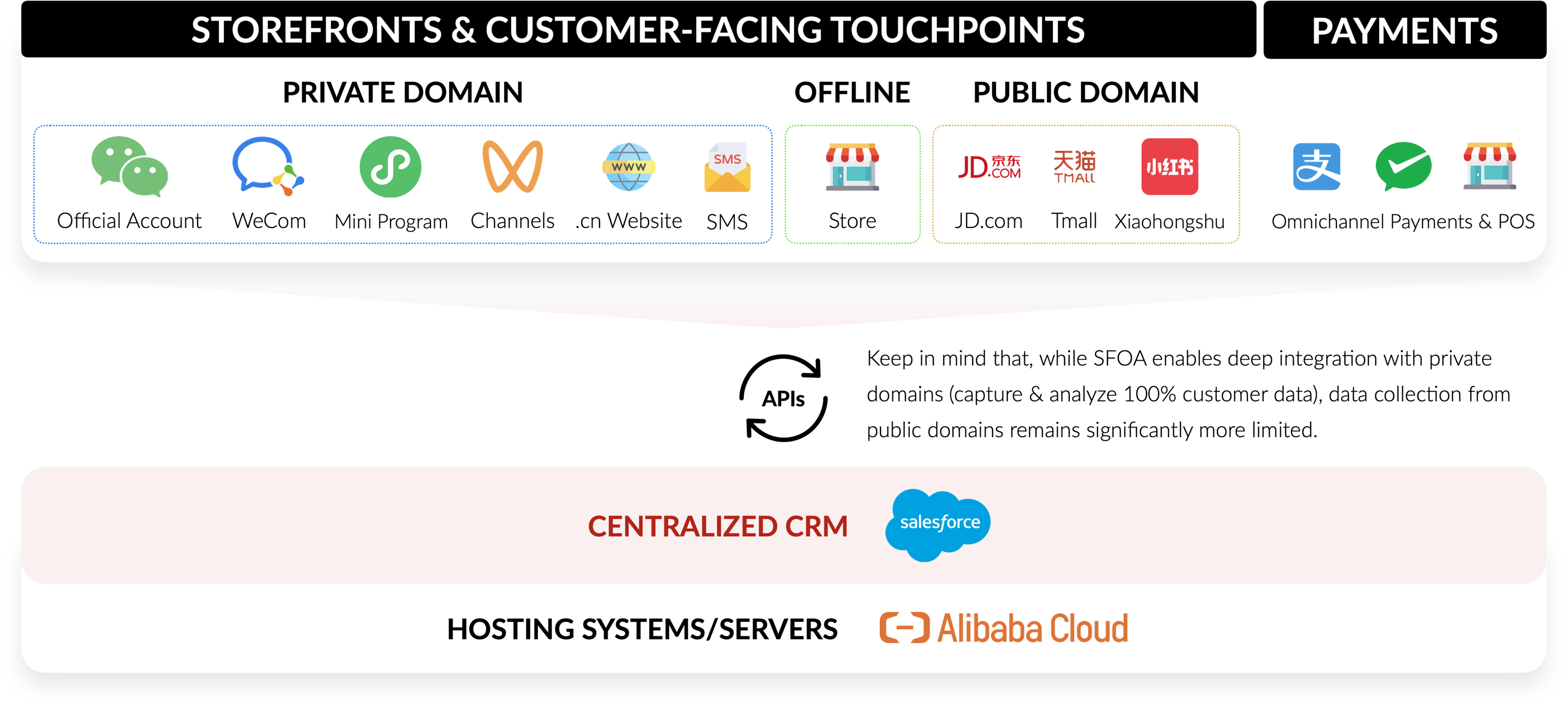
In addition, Salesforce on Alibaba Cloud can seamlessly integrate with and empower WeChat/WeCom operations (Salesforce - Connected Experiences Gateway: Overview and 2024 Vision), boasting features such as:
- 1-1 Realtime Chat with Customers: By adding the new Connected Experiences Gateway Conversation component
- Connect to WeChat Official Accounts/Mini Programs: Scan the QR code to connect them with Salesforce Service Cloud
- Connect to WeCom: Provide the CorpId and related information to connect the brand’s WeCom with Salesforce Sales and Service Cloud
- Store Chat History in Service Cloud: Link WeChat customers with Salesforce Leads/Contacts manually or automatically through a Flow (based on matching UnionIDs), while automatically storing and associating chat history with Service Cloud
- Sync Contact Data from WeCom: Automatically load internal users and external customer contacts into the Salesforce database and automatically sync data daily to Sales Cloud and Customer 360 for comprehensive profiling
- Enable Customer Inheritance: To ensure continuity of the customer experience by synchronizing WeCom and CRM continuously
- Activate Data for Personalized Messaging: Use a localized platform to deliver tailored messages across WeChat, WeCom, and key channels for Chinese consumers
- Build Unified Customer Profiles: Consolidate customer data into a single, comprehensive source of truth, providing valuable insights for personalization, automation, and engagement.
- Build a Bespoke Dashboard: Showcase sales and service performance metrics
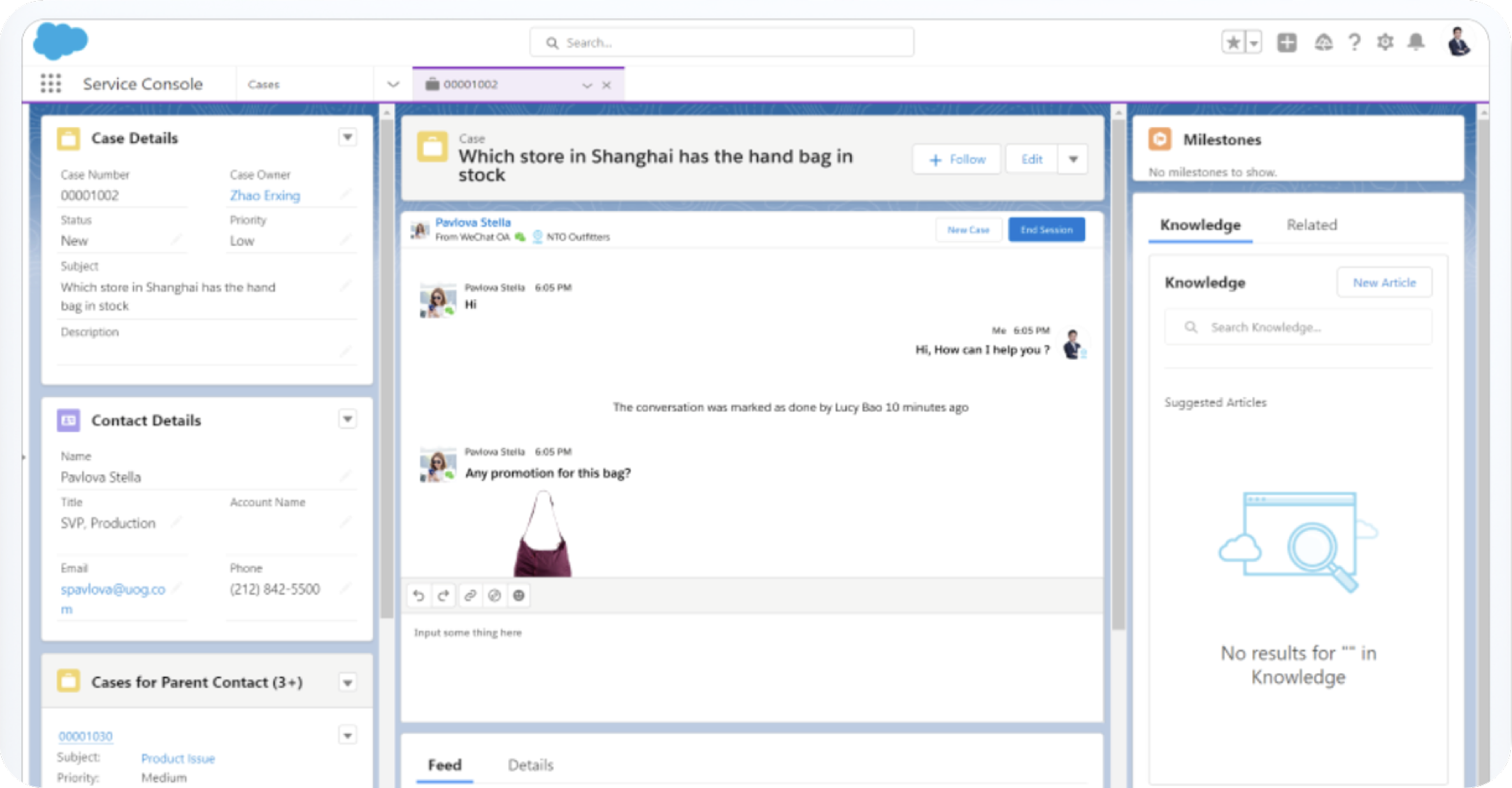

Step-by-Step Guide to Salesforce on Alibaba Cloud Migration
Migrating to Salesforce on Alibaba Cloud requires a structured approach to ensure a seamless transition. The following five-step process is ITC’s proven, high-level methodology that can be customized to fit various industries and business models.
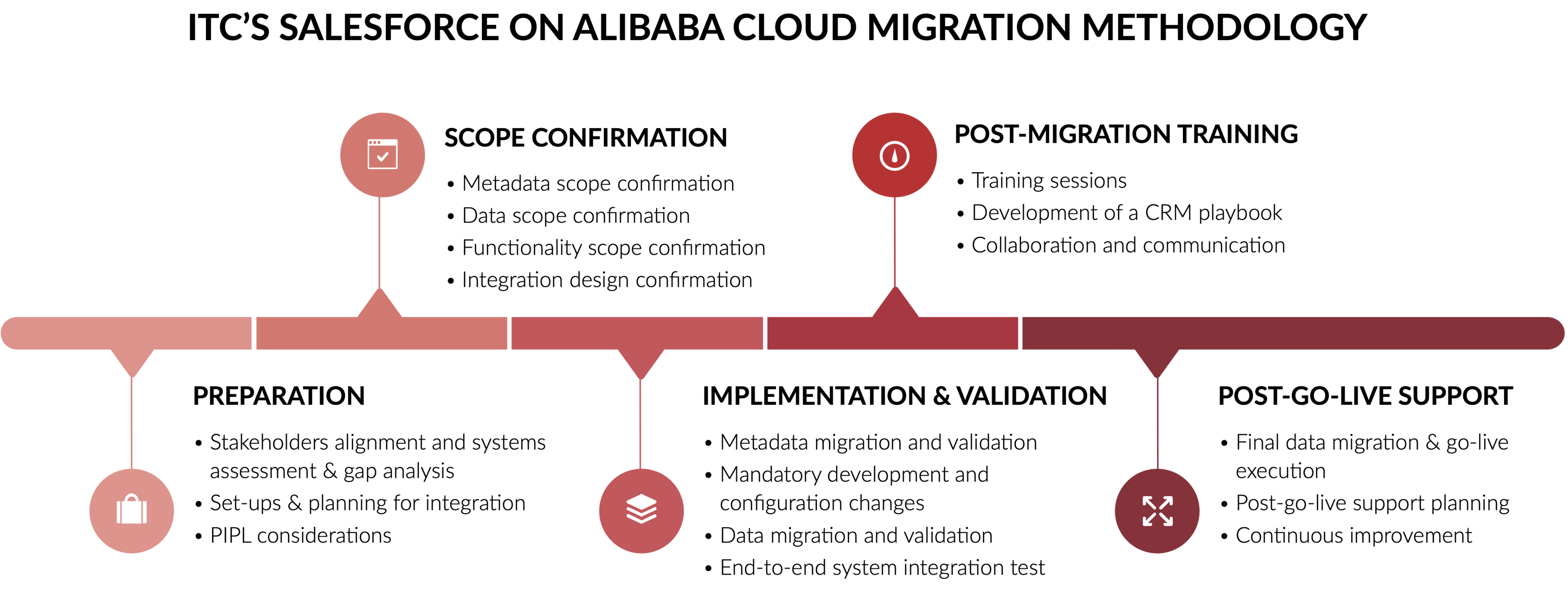
Step 1: Preparation
The Salesforce on Alibaba Cloud - Dreamforce to You event in Shanghai (Nov 2024) stressed the critical importance of change management in successful Salesforce deployment.
Implementing SFOA impacts all end-users (including CRM, Marketing, Sales, IT…) and, by extension, customers, thus requiring alignment with global standards while adapting to local nuances in data governance, operations, and customer experiences.
After conducting educational workshops to align all stakeholders on the challenges, goals, and solutions, brands need to execute a comprehensive system deep-dive for CRM migration and localization, focusing on (but not limited to):
- Current access levels & user roles
- Custom data structures & fields
- Existing processes & workflows
- Customer information management
- Tags & tasks management
- Current integrations with other systems & API configurations (if any)
- Many more…
Brands also need to ensure compliance with the Personal Information Protection Law (PIPL) by carefully selecting and mapping data flows for collection, processing, and cross-border transfers.
Step 2: Scope Confirmation
Once the preparatory work is complete, the next crucial phase is to define the migration scope and envision the ideal future CRM setup. The key steps include:
- Data Scope Confirmation: Define and finalize the data scope, including metadata and selection criteria, and volumes of data to be migrated.
- Integration Design Confirmation: Define future processes and integration frameworks (including workflows and system integrations with other tools & platforms) to ensure smooth operations.

- Compliance Planning: Develop and adhere to compliance guidelines to ensure that the data migration meets local regulatory requirements.
- Infrastructure, Data Fields, Tasks, and Workflows Set-Up: Set up the Salesforce on Alibaba Cloud infrastructure and integrations as planned. Configure data fields, tasks, and workflows to align with future processes, and define user roles and permissions to ensure seamless operation.
Step 3: Implementation & Validation
This stage focuses on executing the migration process while ensuring data integrity, system functionality, and compliance:
- Metadata migration and validation: Ensuring the accurate transfer of all metadata components, such as custom objects, workflows, permission sets, and security settings, to maintain system functionality and compliance.
- Mandatory development and configuration changes: Updating business logic, automation scripts, and integrations (e.g., WeCom, WeChat) where applicable, developing the functionality that is unavailable in SFOA, to ensure system integrity and regulatory compliance.
- Data migration and validation: Extracting, cleansing (removing duplicates and outdated records), transforming, and loading data in structured phases, followed by rigorous validation to confirm accuracy, relationships, and accessibility.
Once data is imported into SFOA, comprehensive system testing must be conducted to verify data integrity, functionalities, and business scenarios, ensuring all configurations perform as expected.
Step 4: Post-Migration Training
Proper education and training are necessary for maximizing the adoption of the new CRM system and standard operating procedures. At ITC, we can support organizations with:
- Targeted Training Sessions: Detailed sessions covering CRM basics for new users, advanced features, and customizations tailored to business needs, ensuring the team is familiar with the updated data structures, new workflows, and any changes in functionality post-migration.
- CRM Playbook Development: A comprehensive CRM strategy and execution playbook tailored for China, seamlessly integrating SFOA with local online and offline touchpoints and business systems to empower seamless omnichannel journeys and maximize conversion and retention.
Step 5: Post-Go-Live
Following deployment, continuous monitoring and optimization ensure long-term success. Key steps include:
- Ensure that user permissions and access levels are correctly configured
- Verify that all configurations are synchronized with the global system
- Conduct a comprehensive review to ensure system integrity
- Address any discrepancies or issues promptly
- Gather end-user feedback and plan optimization work
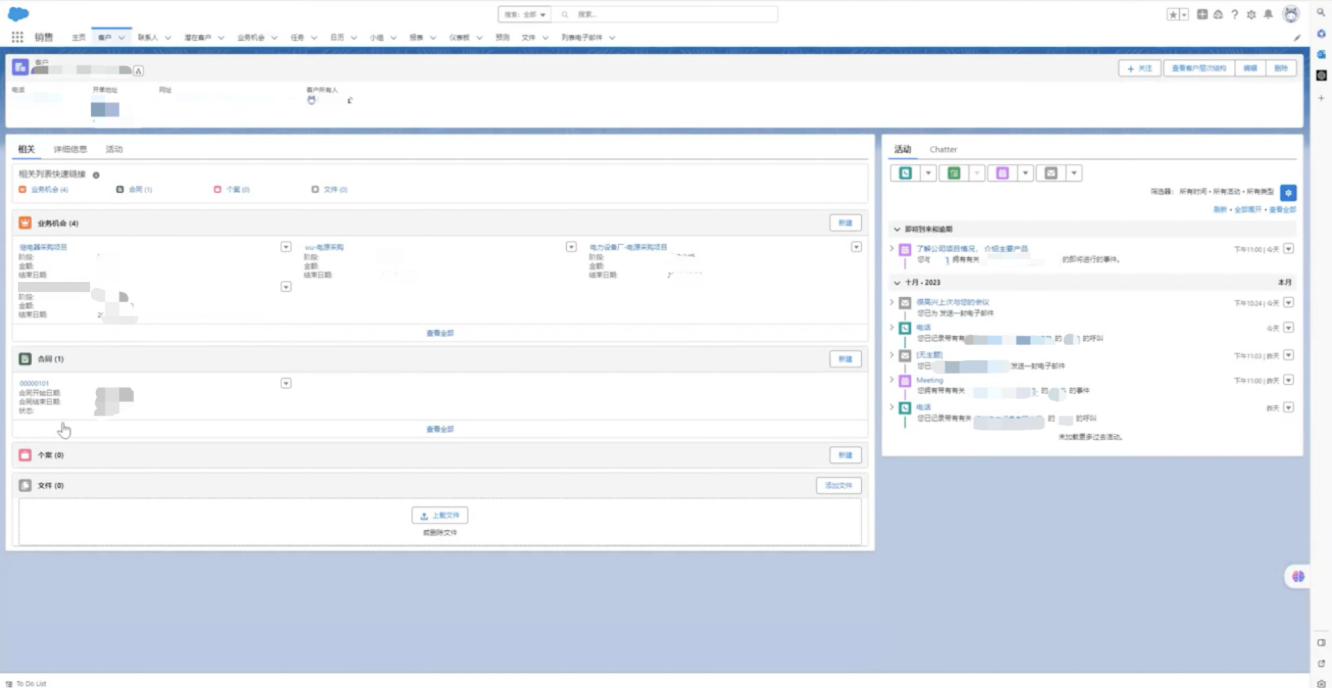
Work with ITC as Your Salesforce Implementation Partner in China
Overall, a well-executed CRM strategy for China demands a unified, compliant, and scalable approach that integrates with the country’s distinct digital ecosystem.
Salesforce on Alibaba Cloud provides the necessary infrastructure to centralize customer data, enhance engagement, and streamline operations while ensuring regulatory compliance. By following our structured CRM migration approach, businesses can achieve seamless integration, maximize data value, and establish a strong foundation for sustained growth in China’s evolving market.
As a certified Salesforce partner, ITC can empower your business with expert onboarding, seamless migration, and end-to-end implementation for Salesforce Global and Salesforce on Alibaba Cloud.
We are also helping brands with WeCom clienteling deployment, localizing global clienteling apps, and seamless integration with SFOA.





